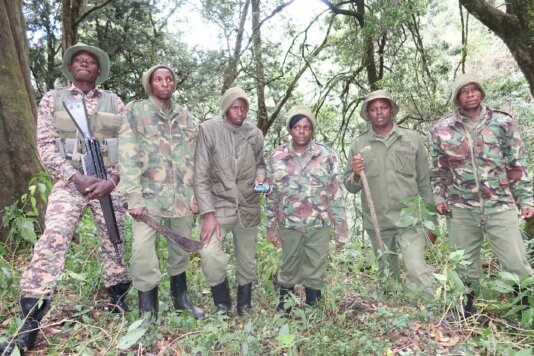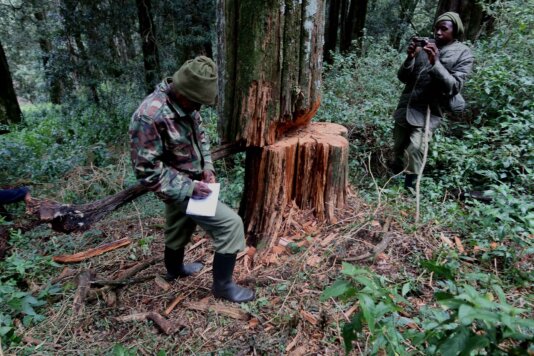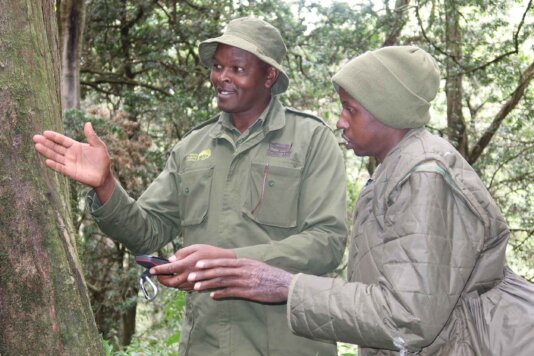- About
- Topics
- Story
- In-Depth
- Picks
- Opinion
- News
- Donate
- Signup for our newsletterOur Editors' Best Picks.Send
Read, Debate: Engage.
| February 08, 2024 | |
|---|---|
| topic: | Hunting & Poaching |
| tags: | #poaching, #wildlife, #conservation, #trafficking, #Kenya, #logging |
| located: | Kenya |
| by: | Bob Koigi |
The global poaching and illegal wildlife trafficking market has been on a steady rise over the years despite concerted efforts to tame it. The illicit wildlife market, valued at an estimated USD 20 billion annually, is driven by a network of organised crime syndicates engaged in poaching and the illegal trade of wildlife. This market thrives on an unrelenting global demand for wildlife products coveted for their commercial and medicinal properties.
Meanwhile, the illegal timber trade is estimated at USD 7 billion annually, accounting for up to 30 per cent of the worldwide wood trade and driven by the demand for nearly extinct species such as rosewood.
Combined, the illicit wildlife and timber markets are classified as the fourth-largest global illegal trade after human trafficking, narcotics and counterfeit products, with up to 100 rangers losing their lives each year to poachers in their line of duty.
While governments and private sector actors have funded and invested in numerous interventions to tame the illicit trade, including by stepping up surveillance, embracing technology and increasing arrests and prosecution of offenders, the practice has largely continued unabated.
But a new strategy is yielding results, largely thanks to community involvement. By transforming reformed poachers into conservation advocates, they can reveal to conservationists the tactics, pathways and tools used in poaching activities. Environmentalists based in Africa have reported a significant reduction in poaching incidents and stronger, more empowered communities following the integration of ex-poachers into conservation efforts.
The expansive Aberdare Range ecosystem in Kenya is home to some of the world’s most endangered flora and fauna, among them black rhinos, bongos, black and white colobus monkeys and the rare African golden cat.
But the ecosystem, which also constitutes one of the key water towers in the East African nation, has been severely affected by poaching, which has decimated the population of some key wildlife species. This trend, coupled with illegal logging, charcoal burning and encroachment, has persisted for years. Until now.
A group of former poachers have stepped up the anti-poaching, anti-logging war by providing on-air and on-the-ground surveillance.
Dubbed The Aberdare Joint Surveillance Unit (AJSU), the group, which was formed in 2010 and consists of seven members, is chaperoned by the conservation organisation Rhino Ark, the Kenya Wildlife Service and Kenya Forest Service. The team is tasked with monitoring illegal activities in the forest, including logging, poaching, carrying out wildlife censuses and putting out wildfires.
The surrounding community has been grappling with a human-wildlife conflict, which has led to crop destruction and the killing of animals as a retaliatory measure. To tackle this, a 400 km electric fence has been erected in a section of the forest. The AJSU unit is tasked with manning the fence.
Their operations begin at the break of dawn, typically around 5:00 am. The aerial support team dispatches coordinates of suspected logging and poaching hotspots within the forest to the unit through GPS. The team then patrols these designated areas for on-the-ground surveillance, escorted by armed rangers from the Kenya Forestry Service and the Kenya Wildlife Service.
In one surveillance round, they reportedly remove up to 15 snares placed by poachers and identify roughly 10 trees that have been illegally logged. The team traverses 700 kms of the forest every month.
"Reformed poachers form an integral part of the team, because they are well versed with rugged terrain and remote nature of Aberdare forest, they already have prior knowledge of the behaviour of wildlife species in Aberdare forest and National Park, and they already know the gangs involved in illegal activities including the time and space where they operate in," Adam Mwangi, Rhino Ark fence and a community manager and in charge of all of the projects in the Aberdare ecosystem, told FairPlanet.
Since the introduction of the unit, illegal activities in the forest have reportedly declined by 80 per cent, and prosecution of wildlife and forest crimes have seen a 90 per cent success rate. The initiative has also generated employment among local communities, according to Mwangi.
"The local community is the focal point of any conservation effort. The participation and involvement of the Aberdare forest-edge community has helped the community to fully own up any conservation effort and resources within the ecosystem," Mwangi noted.
"Community involvement means ‘more eyes’ are keeping vigil on resources in the ecosystem and therefore we are able to gather actionable intelligence information."
The initiative, however, faces various challenges, with the foremost being the evolution of modern loggers and poachers who have grown increasingly sophisticated and devise new, intricate tactics to advance their activities. To counter this, AJSU has employed new strategies such as dark sting operations to catch poachers off-guard and establish intelligence gathering cells.
The sheer size of the Aberdare ecosystem, spanning over 2000 km2, makes it difficult for the unit to cover the entire landscape, which in turn renders the Range vulnerable to illegal activities.
Furthermore, the competing needs from logging, real estate and infrastructure development are jeopardising the ecosystem's conservation. The construction of a controversial road that would slice through the ecosystem while connecting two neighbouring regions is threatening to disrupt local wildlife and exacerbate deforestation. This project has already secured government approval.
"Through Private Public Partnership (PPP) the government and private players have done commendable work in environmental conservation," Mwangi said.
"We have witnessed significant decline in wildlife poaching with resultant increase in population of species such as elephants and rhinos. However, the government needs to strike a balance between environmental conservation and economic development."
Image by Rhino Ark/Zach Okoth.
By copying the embed code below, you agree to adhere to our republishing guidelines.


